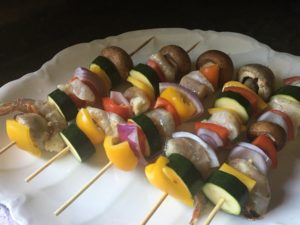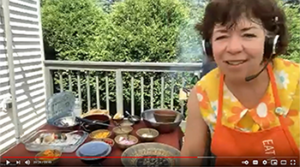I’ve always been a fish fan. Though I didn’t grow up in Wisconsin, both of my parents hailed from the Badger State, so the fish-fry culture is in my blood. Of course, there’s a lot more to eating fish than deep frying it, which is why I hopped on to a recent live webinar offered by the Great Lakes Aquaculture Collaborative—of which Wisconsin Sea Grant is a part—and hosted by Ohio Sea Grant.
“Fish to Fork: Grilling in the Great Lakes” featured my colleague here at Wisconsin Sea Grant, Sharon Moen, as well as two Sea Grant-ers from my home state of Michigan, Lauren Jescovitch and Elliot Nelson. Sharon runs our Eat Wisconsin Fish initiative, working with fish farmers, commercial fishers and consumers.

Shrimp and veggie kabobs ready for the grill.
Sharon, Lauren and Elliot put on a lively session via Zoom, with Lauren and Elliot beaming in from their kitchens in Michigan’s U.P., and Sharon from her tree-lined deck in the Twin Ports area (Duluth/Superior).
While I encourage you to watch the recording yourself to pick up some fish tips, I thought I’d blog some of my impressions and takeaways from these three experts.
When possible, they said, it’s great to get your fish directly from local producers, such as a fish farmer in your area or commercial fishers. That way, you know your product is very fresh and you can ask questions about how it was raised or caught. And because these products (whether farmed or wild-caught) are highly regulated in the U.S., you can feel confident you’re getting a safe product.
If you can’t buy direct from a producer or at a specialty fish market, you’re probably picking up your fish at a large grocery store or big-box store. Labels are your friend! Elliot, an extension educator covering Michigan’s eastern U.P., suggests finding out where the fish or seafood came from. You might be surprised to find some local or regional choices.
Also, noted Elliot, don’t assume that the fresh fish counter is automatically superior to the freezer section. Sometimes “fresh” fish at the counter can be past its prime. Avoid mushy textures, strong fishy odors or things that look opaque or cloudy.
In the frozen section, you don’t want to see ice on the outside of the bag or on freezer shelves, but ice inside the bag is fine. Vacuum-sealed products are also a good way to go.
Lauren, an extension educator covering the western U.P., preceded Elliot with an impressive—and only slightly gory—demonstration of how to gut and fillet whole fish.
Lauren recommended gutting smaller fish, leaving them more or less intact, then placing seasonings inside before cooking. She used fish from the Watersmeet Trout Hatchery, as well as a local maple barbecue seasoning rub. For larger fish, she recommended filleting.
Impressively, during the live hour on Zoom, she cooked her clean, gutted trout on an indoor grill and then showed the removal of skin and pin bones before eating. While I know she’s had plenty of practice, it looked very do-able!

Sharon Moen makes a fish kabob during a live webinar hosted by Ohio Sea Grant.
While Elliott focused on food selection and safety, and Lauren showcased her knife skills, Sharon assembled a colorful, healthy kabob for an outdoor grill, using a combo of shrimp, catfish, trout and vegetables. She showed off her finished product at the end of the hour, which looked to have just the right amount of char on the veggies.
I’ll be sure to invite myself over to Sharon’s next time I’m in the Twin Ports—both the skewers and her deck looked fabulous on a summer’s day. Add a glass of wine, and that’s my idea of a perfect summer lunch or dinner!
You can find Sharon’s kabob recipe, Fishes on Sticks, on the Eat Wisconsin Fish website. And to hear more from Sharon, check out her June 19 appearance on the Buckeye Sportsman radio show, when she chatted with host Dan Armitage about grilling fish and more (Sharon’s segment runs from 14:15-30:38 on the recording).
As Elliot said near the end of the hour, there’s “a bounty of flavors when it comes to seafood,” and preparation doesn’t have to be complex. If you watch the archived webinar from this trio of fish experts, I’m sure you’ll agree.
In the meantime, here are some Sea Grant-supported web resources that that can help you find producers, specialty fish markets, recipes, health info and more:


